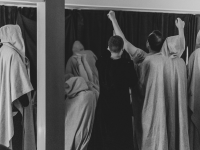The current common safety practices of flagging someone as unsafe to attend a larp were created to handle predators in the scene, specifically to protect sexual assault survivors. However, flagging is also commonly used to prevent people from attending a larp for lesser reasons, such as a bad breakup, disliking someone’s communication or playstyle, simply feeling uncomfortable around someone, or loyalty to a friend who experienced bad behavior from the person. Our goal with this article is to bring these issues into the open for further discussion.
While created with the best of intentions, flagging as the main safety practice has helped create several undesirable consequences that negatively impact the larp community. These include: an imbalance and misuse of anonymous, concentrated, and hoarded power; a toxic culture of pre-emptive or retaliatory flagging to avoid any potential interaction outside a narrow comfort zone; and a requirement for organizers to become police, judge, jury or relationship therapist for attendees.
The current common flagging practice used to ensure event safety in many international larps consists of providing a list of participants to everyone planning to attend. Participants then can anonymously flag other players as unsafe, meaning people who should not be at the event at all, or as someone they don’t want to play with. Typically, people who are flagged unsafe are removed from the event while the flagger gets in. The flagging is not questioned and stays anonymous, although sometimes organizers will investigate and discuss the matter as much as they can without risking the anonymity of the flagger.
Although this practice helps protect the flagger, it is increasingly problematic because anonymity creates space to abuse the system, not unlike how discourse degrades in online forums where a person’s identity is hidden. Additionally, the scope and intention of the flagging system, built to stop sexual assaults, has changed. It has become a system to protect one’s comfort zone instead or to shift responsibility for managing one’s emotions and interactions to a third party. As a game organizer, Nina for example has seen flagging reasons such as: ”They sent me too many messages after a larp and I felt uncomfortable”, “They are my ex and it’s awkward.” and ”They always complain after a larp and cry too often.” Maury has also seen reasons for flagging including “They have a big ego and dominate play” and “They were abusive to my friend in a past relationship.”
When these types of reasons are used – and succeed in removing others from a larp – flagging is no longer about player safety. Flagging is being used to avoid resolving conflict that is an inevitable part of human contact in any community and to create cliques of players who ostracize others. People whose behavior is disliked in any way, especially cis men, get dropped from larps and, in worst case scenarios, ostracized from the larger larp community, because they may have behaved in a way that made someone uncomfortable. Flagged players generally do not get information on how to improve, denying them the opportunity for restoration.
Knowing that you can get someone removed from a larp simply by anonymously clicking a cell in a spreadsheet leads to a misuse of power. A player who does not like another player can simply flag them and ensure they will not have to see them at an event. The threat of weaponizing the flagging safety practice is also unfortunately common. Nina for example, has been threatened that they will be flagged as an unsafe player from now on unless they stop talking about an issue in the community, online and outside of larp events. Misusing the power inherent in the system for your own gain is all too easy. Being flagged once can also lead to a cycle of continued flagging, using the rationale that if another larp removed them, there must be a valid reason.
Flagging creates problems for organizers too, who need to act as investigators, mitigators, police, judge and jury unless they simply drop all flagged people without question, which leads to the problems already described. Organizers may also be asked to perform hours of emotional labor listening to players in conflict. Adding the responsibility to guarantee safety of participants to this is a huge amount of work that is highly biased, mainly based on rumors, and ultimately thankless. Any larp organizer who does not drop a flagged person, for whatever reason, risks being called unsafe themselves, leading to backlash, ostracization and even abuse from players who disagree with an organizer decision.
No set of safety tools and player support systems will guarantee that every moment of every larp is free of situations that may be problematic or outside of a particular player’s comfort zone.
We recognize that there is no easy answer to the important issue of protecting player safety, and that this is a difficult conversation. Sadly, bad actors will learn to weaponize any safety system put in place, so the system must evolve in order to stay relevant and continue to do the greatest good possible.
This article has been reprinted with permission from the Solmukohta 2024 book. Please cite as:
Brown, Maury, and Nina Teerilahti. 2024. “Flagging is Flawed.” In Liminal Encounters: Evolving Discourse in Nordic and Nordic Inspired Larp, edited by Kaisa Kangas, Jonne Arjoranta, and Ruska Kevätkoski. Helsinki, Finland: Ropecon ry.
Photo credit: Image by Julien Tromeur from Pixabay. Image has been cropped.






